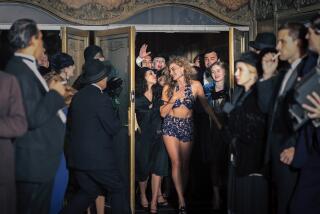AROUND HOME : Old Telephones
- Share via
TOMORROW’S POCKET-SIZED cellular videophone seems unrelated to the battery contraption through which Alexander Graham Bell shouted in 1876; yet the basic components remain the same.
Sound vibrating through a thin metal diaphragm still activates carbon granules beneath it. Their movement converts sound waves into electrical patterns. Traveling through a central exchange, this fluctuating current creates an electromagnetic field in the receiver, attracting another vibrating diaphragm that reconverts electric to acoustic energy, reproducing the sound. Each telephone still needs a dial or tone-panel (to signal the exchange), a bell (triggered by the exchange), a “hang up” (to disconnect power) and a chassis.
Bell, unaware of his invention’s multi-trillion-dollar annual potential, offered it to Western Union for $100,000. The deal was turned down. Within two years, however, telephones linked the continent. Booths and directories followed in 1880, Western Electric plants in 1882, transatlantic calls in 1887, automatic switching devices in 1889, pay phones in 1891 and dials in 1906.
Since then, only the chassis has kept changing. New styles introduced yearly have included the 1912 “face mask” for privacy and the 1929 “dial thimble.” Refurbished with modular plugs and touch-tone panels, many still work perfectly--to the appreciation of collectors and decorators.
The earliest crank telephones had wall-mounted mouthpieces. The tall “candlestick” arrived in 1892, the year Europeans first designed “single handsets,” not produced in the United States until 1928. Some considered telephones vulgar despite their popularity and hid them beneath papier-mache angels or hoop-skirted dolls.
The most well stocked old-telephone stores are Phoenix Phones in Claremont (models from 1890 to 1950); Billard’s Old Telephones in Cupertino (1878 to 1950 instruments and parts), and Telephone Salvage in Van Nuys (‘40s and ‘50s phones, switchboards and booths). Nostalgic metal and Bakelite Deco phones are sold by Harvey’s and Thanks for the Memories in Los Angeles; ABCO Enterprises in Arleta, and Speakeasy in Pasadena. Bee Enterprises in Sylmar has wooden wall models. Dr. Phones in Garden Grove has one-of-a-kind cartoon-character phones. Antique reproductions are sold by some GTE Phone Marts.
More to Read
Inside the business of entertainment
The Wide Shot brings you news, analysis and insights on everything from streaming wars to production — and what it all means for the future.
You may occasionally receive promotional content from the Los Angeles Times.










